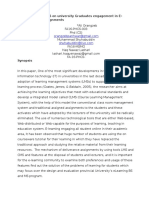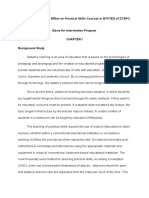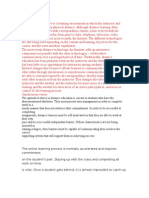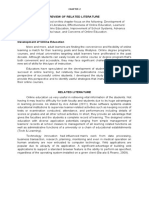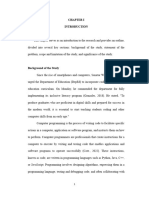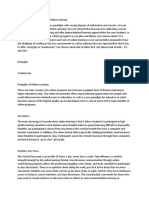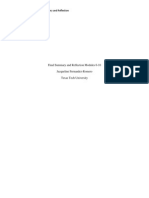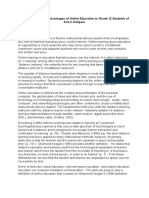U01a1 Audience&environmentalanalysis Stirling
U01a1 Audience&environmentalanalysis Stirling
Uploaded by
api-281661547Copyright:
Available Formats
U01a1 Audience&environmentalanalysis Stirling
U01a1 Audience&environmentalanalysis Stirling
Uploaded by
api-281661547Original Title
Copyright
Available Formats
Share this document
Did you find this document useful?
Is this content inappropriate?
Copyright:
Available Formats
U01a1 Audience&environmentalanalysis Stirling
U01a1 Audience&environmentalanalysis Stirling
Uploaded by
api-281661547Copyright:
Available Formats
Running head: AUDIENCE AND ENVIRONMENTAL ANALYSIS
Audience and Environmental Analysis
Anna Stirling
Capella University
ED7814: Interface Design
Vern Czelusniak, PhD
January 8, 2015
AUDIENCE AND ENVIRONMENTAL ANALYSIS
In 2013 the California Community Colleges Online Education Initiative was formed as
part of a legislative grant initiative. The mission of the California Community Colleges Online
Education Initiative (OEI) is to dramatically increase the number of California Community
Colleges (CCC) students who obtain college associate degrees and transfer to four-year colleges
each year by providing online courses (California Community Colleges Online Education
Initiative, 2013). Additionally, OEI will pay special attention to the success and retention rates
of distance education courses.
The California Community College system educates over 2 million students each year
(Scott, 2011). In the 2009-2010 academic year, over 600,000 of those students enrolled in one of
nearly 40,000 distance education courses offered (Scott, 2011). However, success rates for
distance education courses for that same year were only 57% compared to 67% in traditional
classrooms, and retention rates were similar with 78% online and 85% traditional (Scott, 2011).
While there are numerous variables that contribute to the differences in success and retention
rates, course design is one variable that can be addressed. In the California Community College
system professors have academic freedom; this means that they can design and deliver
instructional materials and assessments without interference by administration. Although all
faculty members are required to use the same learning management system at the institution
where I work, this academic freedom still poses a problem for online students. Students struggle
with online success because every course is laid out differently, requires different tools to be used
and has varying expectations for technology skills in addition to the course curriculum.
Unfortunately, in my opinion, many online courses offered in the California community college
system are poorly designed. Not because the faculty who teach them are not subject matter
AUDIENCE AND ENVIRONMENTAL ANALYSIS
experts, but simply because they are just that, subject matter experts. They arent course design,
or even education, experts.
After teaching online for numerous years, and assessing my students performance
throughout those years, I realized that my students were not prepared to be successful in my
course. In fact, many of them were unprepared for college curriculum in general. ACT (2013)
corroborated this sentiment in their 2013 The Reality of College Readiness report by stating that
only 25% (p. 3) of high school graduates met all four benchmarks of college readiness. In
addition to being unprepared, students are required to learn how to use a variety of tools both in
and outside of the learning management system to successfully complete each online course.
Because course requirements and design are not standardized, students may need to learn a
different set of tools for each course. Furthermore, they may be using the same tool, but in a
different way or to accomplish a different type of task across courses.
When these two conditions, poor course design and student unpreparedness, are
combined students are set up for failure; low success and retention rates are the manifestation of
that failure. While students in online courses have a wide variety of experience and comfort
levels with learning management systems, all students must understand the expectations for each
course they enroll and determine how the tools will be used for each. This can reduce the
amount of time they have available to learn the course curriculum reducing success rates. It can
also cause stress, and potentially cause students to withdraw from a course (lower retention
rates). In an effort to help students be able to navigate the course environment and use the
desired tools with ease, I plan to design a course specific online orientation for an online
Microsoft Access course taught at a California Community College. The orientation will
AUDIENCE AND ENVIRONMENTAL ANALYSIS
introduce course expectations and provide a low risk practice environment for students to
become comfortable with the specific tools used to meet the course objectives.
Audience and Environmental Analysis
Focus of
Investigation
Information Gathered
The domain
The orientation will be located in the MSJC Blackboard LMS. Users
will have varying levels of proficiency, from none to competent, with
the LMS.
The users
Primary users are MSJC students (CA community college), secondary
users are MSJC faculty, support staff & administrators
Characteristics of
the users
MSJC students have a wide variety of characteristics, including
demographic and cultural, that influence learning. Currently MSJC
serves approximately 18,000 students: 58% of those students are female;
60% of the student population is under the age of 25; 38% of students
are Hispanic; 6% are disabled; and almost 90% assessed into below
college level English (MSJC Institutional Research Department, 2013).
Characteristics of
the task
Users are required to learn how to use a variety of tools both in and
outside of the LMS to successfully complete the course requirements.
Because course requirements and design are not standardized, students
may need to learn a different set of tools for each course. The goal of the
orientation is to provide a low risk practice environment for users to
become comfortable with the course LMS environment.
Physical
environment
The course and orientation are offered online, so the physical
environment of users will vary greatly depending on where they access
the course from. Users may access the course from any computer with
internet access.
Social
environment
The orientation must be completed for users to continue participation in
the online course. This may increase the pressure to perform; however,
in an effort to reduce associated stress, users have multiple attempts to
complete the orientation activities. Users may seek help from peers or
tutors to complete the orientation activities, but collaboration is not
required.
AUDIENCE AND ENVIRONMENTAL ANALYSIS
Focus of
Investigation
Information Gathered
Organizational
environment
MSJC is dedicated to providing online courses in an effort to meet the
needs of a diverse student population. As this course is offered as an
academic course that is part of a degree program, the course must
comply to all public education rules and regulations prescribed for
community college courses by the federal, state and local agencies.
Users will earn a letter grade upon completion of the course the
orientation activities will be part of the formative assessment procedures
used to earn the letter grade.
User support
The orientation is designed as a help guide for navigating and
interacting with the online course environment. In addition to the
resources provided in the orientation activities, users may seek help
from peers, the course instructor, and college provided tutors and
support staff. Users may also research additional help resources on the
internet.
Qualitative
usability aspects
The goal of the orientation is to help users understand and develop a
level of comfort with the LMS. As such, the interface should be easy to
navigate and learn and should take advantage of user preconceptions.
Quantitative
usability goals
By the end of the course specific orientation users will be able to
navigate the online course environment and use the desired Blackboard
LMS tools with ease.
Constraints
The orientation is constrained by the capabilities of the Blackboard
LMS. The cost associated with the development of the orientation will
be assumed by the instructor as part of the course design and delivery
compensation. All activities will be created using free or previously
licensed software (no additional software will be acquired to complete
the design or delivery of content).
Trade-off
The orientation will replace the first week of course curriculum delivery.
This will require adjustment to the current course design, potentially
combining curriculum objectives later in the course delivery.
AUDIENCE AND ENVIRONMENTAL ANALYSIS
References
ACT. (2013). The reality of college readiness 2013 national. Iowa City: ACT.
California Community Colleges Online Education Initiative. (2013, November 14). About.
Retrieved from California Community Colleges Online Education Initiative:
http://ccconlineed.org/about
MSJC Institutional Research Department. (2013). MSJC Stats AY12-13. San Jacinto: Mt. San
Jacinto College. Retrieved from
http://www.msjc.edu/CollegeInformation/Administration/InstitutionalResearch/Documen
ts/MSJC%20Stat%20AY12-13.pdf
Scott, J. (2011). Distance education report. Sacramento: California Community College
Chancellor's Office.
Stone, D., Jarrett, C., Woodroffe, M., & Minocha, S. (2005). User interface design and
evaluation. San Francisco: Elsevier.
You might also like
- Dueñas General Comprehensive High School 1 Learning Action Cell (LAC) Session Minutes of The MeetingDocument12 pagesDueñas General Comprehensive High School 1 Learning Action Cell (LAC) Session Minutes of The MeetingLawrence Mae Asong Pamotillo II100% (13)
- The Mary Celeste Mystery ReadingDocument2 pagesThe Mary Celeste Mystery ReadingEmilio Hernandez50% (4)
- The Effect of Online Educational Learning PlatformDocument11 pagesThe Effect of Online Educational Learning PlatformJaylou M. TaboriteNo ratings yet
- Hybrid Learning Chapter 1Document11 pagesHybrid Learning Chapter 1Dick Jefferson Ocampo PatingNo ratings yet
- The Impact of C/LMS On University Graduates Engagement in E-Learning Based AssignmentsDocument8 pagesThe Impact of C/LMS On University Graduates Engagement in E-Learning Based AssignmentsAnonymous r4X2ZS3RDNo ratings yet
- Renuka Kumar, The Associates OMDE 608 Section: 9040 April 18, 2015 Response To Case StudyDocument10 pagesRenuka Kumar, The Associates OMDE 608 Section: 9040 April 18, 2015 Response To Case Studyapi-203957350No ratings yet
- Distance Learning and Effect On Practical Skills Courses in BTVTED of ZCSPCDocument12 pagesDistance Learning and Effect On Practical Skills Courses in BTVTED of ZCSPCMae CherryNo ratings yet
- Ist626 Qms 1 8Document58 pagesIst626 Qms 1 8api-265092619No ratings yet
- ConclusionDocument7 pagesConclusionEng Jye NgNo ratings yet
- Guidelines For Observation of Online TeachingDocument16 pagesGuidelines For Observation of Online TeachingIriskathleen AbayNo ratings yet
- Hybrid LearningDocument31 pagesHybrid LearningDick Jefferson PatingNo ratings yet
- Online Class Proposal Edtc5503Document9 pagesOnline Class Proposal Edtc5503api-201648540No ratings yet
- Distance LearningDocument10 pagesDistance LearningAwgNaziroolFxNo ratings yet
- Ortiz S TPDP 2Document66 pagesOrtiz S TPDP 2api-464335930No ratings yet
- Review of Related LiteratureDocument5 pagesReview of Related LiteraturenyakNo ratings yet
- Distance Education PaperDocument6 pagesDistance Education Paperapi-339411742No ratings yet
- Schoology Implementation PlanDocument13 pagesSchoology Implementation Planapi-320708415100% (1)
- Student Faculty College Management (Dean, Hods, Principal) Administrator Student Faculty College Management (Dean, Hods, Principal) AdministratorDocument8 pagesStudent Faculty College Management (Dean, Hods, Principal) Administrator Student Faculty College Management (Dean, Hods, Principal) AdministratorAitezaz Ahsan Aitezaz AhsanNo ratings yet
- RichardsonS Project02 503Document6 pagesRichardsonS Project02 503shellyshome71No ratings yet
- ResearchDocument4 pagesResearchLubeth CabatuNo ratings yet
- Omde 601Document2 pagesOmde 601api-241955651No ratings yet
- Blended Learning: F. Tañedo Street Cor. Mcarthur Highway, Tarlac City, Philippines 2300 Email Address: WebsiteDocument8 pagesBlended Learning: F. Tañedo Street Cor. Mcarthur Highway, Tarlac City, Philippines 2300 Email Address: Websiteclara dupitasNo ratings yet
- Main Paper11 1Document27 pagesMain Paper11 1LA NceNo ratings yet
- Literature Review On Modular KitchenDocument7 pagesLiterature Review On Modular Kitchenfvf2j8q0100% (1)
- Revised Synthesis PaperDocument10 pagesRevised Synthesis Paperapi-270732603No ratings yet
- Descriptive SWOT Analysis About Online LearningDocument10 pagesDescriptive SWOT Analysis About Online LearningChristopher M. LeeNo ratings yet
- Ehrhardt Oesis Mechanics of Online EdDocument21 pagesEhrhardt Oesis Mechanics of Online EdJonathan E. MartinNo ratings yet
- EDUC 512 - Instructional Applications of Productivity SoftwareDocument10 pagesEDUC 512 - Instructional Applications of Productivity Softwaremrounds5No ratings yet
- Descriptive Swot Analysis About Online LearningDocument10 pagesDescriptive Swot Analysis About Online LearningMadhusudan MNo ratings yet
- Revised Tech Improvement PlanDocument12 pagesRevised Tech Improvement Planapi-270732603No ratings yet
- Connections Academy District Technology Training Plan Erin Adelsberger University of Maryland, University College March 30, 2014Document16 pagesConnections Academy District Technology Training Plan Erin Adelsberger University of Maryland, University College March 30, 2014erinadelsNo ratings yet
- Strengths and Weaknesses of Online LearningDocument6 pagesStrengths and Weaknesses of Online LearningAllan TomasNo ratings yet
- Courseras Drivers of Retention in Online Degree Programs Report 1Document24 pagesCourseras Drivers of Retention in Online Degree Programs Report 1ahmed.hany817818No ratings yet
- Omde 608 Assignment 3 - DavisDocument8 pagesOmde 608 Assignment 3 - Davisapi-298237027No ratings yet
- Complete Students Enrollment Chapter OneDocument7 pagesComplete Students Enrollment Chapter OneprogressivecompoundNo ratings yet
- Blended LearningDocument16 pagesBlended LearningKartik KumarNo ratings yet
- 5 Assumptons OJDLA PDFDocument7 pages5 Assumptons OJDLA PDFdaveasuNo ratings yet
- WK 7 ProjmorlantDocument9 pagesWK 7 Projmorlantapi-314700921No ratings yet
- Who or What Contributes To Student Satisfaction in Different Blended Learning Modalities?Document18 pagesWho or What Contributes To Student Satisfaction in Different Blended Learning Modalities?colegiulNo ratings yet
- LDWBC Learning Continuity Plan (LCP) - DraftDocument28 pagesLDWBC Learning Continuity Plan (LCP) - DraftLaarni Samonte CerenoNo ratings yet
- Critical Issues - Competency Based and Online EducationDocument6 pagesCritical Issues - Competency Based and Online Educationapi-296418803No ratings yet
- An Assessment Framework For The Community CollegeDocument35 pagesAn Assessment Framework For The Community CollegeYogesh KharadeNo ratings yet
- School of Arts & Sciences Course Syllabus: Click Here For Learning Outcomes BA Social WorkDocument7 pagesSchool of Arts & Sciences Course Syllabus: Click Here For Learning Outcomes BA Social Workapi-432879932No ratings yet
- Hughes JA. Supporting The Online LearnerDocument6 pagesHughes JA. Supporting The Online LearnerlhouieNo ratings yet
- Case Study ReportDocument17 pagesCase Study ReportBriel SanchezNo ratings yet
- The Student Engagement GuideDocument9 pagesThe Student Engagement GuideAmanda L ShoreNo ratings yet
- Conlon 1997Document11 pagesConlon 1997AngelooNo ratings yet
- Schoology-Learning Management SystemDocument42 pagesSchoology-Learning Management SystemRechelleRuthM.Deiparine100% (2)
- 608 Libermanl A3Document11 pages608 Libermanl A3api-241955651No ratings yet
- Final Summary and Reflection Modules 6-10Document8 pagesFinal Summary and Reflection Modules 6-10api-264575628No ratings yet
- How Do Online Course Design Features Influence Student Performance?Document39 pagesHow Do Online Course Design Features Influence Student Performance?Missy ArguellesNo ratings yet
- Eci502 Assignment8 Evaluation Kathleen KellerDocument8 pagesEci502 Assignment8 Evaluation Kathleen Kellerapi-250951625No ratings yet
- Schoology ProposalDocument10 pagesSchoology Proposalapi-248437743No ratings yet
- WK 7 AssgnchoecDocument7 pagesWK 7 Assgnchoecapi-322001954No ratings yet
- Annotated Bibliography TemplateDocument3 pagesAnnotated Bibliography TemplateQandel N. SaberNo ratings yet
- Descriptive SWOTAnalysisabout Online LearningDocument11 pagesDescriptive SWOTAnalysisabout Online Learningsyabbayamtaz.mp21aNo ratings yet
- Addie Analysis PaperDocument11 pagesAddie Analysis Paperapi-344649238No ratings yet
- Advantages and Disadvantages of Online Education To Grade 12 Students of ACLC AntipoloDocument4 pagesAdvantages and Disadvantages of Online Education To Grade 12 Students of ACLC AntipoloJane Sandoval0% (1)
- Research MethodologyDocument6 pagesResearch Methodologyà S ÀdhìkãríNo ratings yet
- Cantomayor (Activity 5)Document4 pagesCantomayor (Activity 5)Maricel CantomayorNo ratings yet
- Evaluating Your College's Commitment to the Recruitment & Retention of Students of color: Self-Evaluation InstrumentFrom EverandEvaluating Your College's Commitment to the Recruitment & Retention of Students of color: Self-Evaluation InstrumentNo ratings yet
- Supporting Lagging Students and Learning for All: Applying the Diagnose-and-Supplement System of Basic Skills in the Republic of KoreaFrom EverandSupporting Lagging Students and Learning for All: Applying the Diagnose-and-Supplement System of Basic Skills in the Republic of KoreaNo ratings yet
- Cmcsis DSP CcsDocument30 pagesCmcsis DSP CcsAdemário carvalhoNo ratings yet
- RC60 - 72H Kubota 60" Deck Parts BookDocument17 pagesRC60 - 72H Kubota 60" Deck Parts Bookbrja73gmailNo ratings yet
- Question Bank 3 and 4 UnitDocument8 pagesQuestion Bank 3 and 4 Unitanlacetech133No ratings yet
- Biology: Books & PublicationsDocument15 pagesBiology: Books & PublicationsMuntaha IjazNo ratings yet
- Case3 Maam MelisaDocument3 pagesCase3 Maam MelisaKay Tracey UrbiztondoNo ratings yet
- The Use Case DiagramDocument18 pagesThe Use Case DiagramchellaanilkumarNo ratings yet
- UnderDoubleEagle TousignantDocument31 pagesUnderDoubleEagle TousignantLarry GehringNo ratings yet
- Adamczyk Resume 2019 5Document2 pagesAdamczyk Resume 2019 5api-511630954No ratings yet
- Development of Education System in Kenya Since IndependenceDocument10 pagesDevelopment of Education System in Kenya Since IndependenceNelsonMoseMNo ratings yet
- Self-Discipline Worksheets: Welcome To "Building Great Character"Document4 pagesSelf-Discipline Worksheets: Welcome To "Building Great Character"astroNo ratings yet
- 10 Work On Mud PumpsDocument5 pages10 Work On Mud PumpsdraghiceanuNo ratings yet
- 2-Mechanisms of StrengtheningDocument18 pages2-Mechanisms of StrengtheningRalph Victor MalimetNo ratings yet
- Eee f431 MTNDocument2 pagesEee f431 MTNdubstepoNo ratings yet
- WFT255034 OmniWellDocument16 pagesWFT255034 OmniWellHugoNo ratings yet
- Deep Vein ThrombosisDocument4 pagesDeep Vein ThrombosisAgatha FeliciaNo ratings yet
- 1 AC 200 282C ILT 001 Syllabus Introduction AppendicesDocument36 pages1 AC 200 282C ILT 001 Syllabus Introduction AppendicesaaaguilarmNo ratings yet
- OutlinesofancientDocument211 pagesOutlinesofancientpstrlNo ratings yet
- Bus AssignmentDocument21 pagesBus AssignmentUllash JoyNo ratings yet
- EL 114 Lesson 5 - Philippine LiteratureDocument2 pagesEL 114 Lesson 5 - Philippine LiteraturechumpabonNo ratings yet
- Soil Chemistry: CHM 001 Chemistry For EngineersDocument40 pagesSoil Chemistry: CHM 001 Chemistry For EngineersEjay CabangcalaNo ratings yet
- Class 2 Nso 3 Years Sample PaperDocument9 pagesClass 2 Nso 3 Years Sample PaperUmesh75% (4)
- Revised FInal ProjectDocument131 pagesRevised FInal Projectjlwth9No ratings yet
- Horizontal & Vertical Structure For Work Organization: Kukuh Faedlur Rahman 14522125Document4 pagesHorizontal & Vertical Structure For Work Organization: Kukuh Faedlur Rahman 14522125kukuhricardoNo ratings yet
- Soil AnalysisDocument4 pagesSoil AnalysisGeetha KarthikeyakumarNo ratings yet
- Physics: DPP - Daily Practice ProblemsDocument3 pagesPhysics: DPP - Daily Practice Problemslalithasaranya018No ratings yet
- Instruction Manual: Propane Insect FoggerDocument12 pagesInstruction Manual: Propane Insect Foggeranon_985994571No ratings yet
- 21st Century ModuleDocument12 pages21st Century ModuleDariel V. FloresNo ratings yet
- SAILMA Grades Steel Plates & SheetsDocument2 pagesSAILMA Grades Steel Plates & SheetsElumalai SrinivasanNo ratings yet




